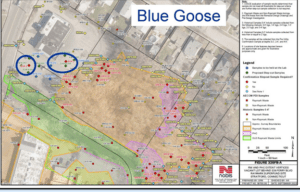Wednesday, November 29, 2023
Town of Stratford
Since the work began in 2020, contractors have extracted more than 80,000 cubic yards or nearly 7,000 truckloads of waste from about two dozen polluted properties, said Jim DiLorenzo, an environmental engineer with the U.S. Environmental Protection Agency.
DiLorenzo said the agency estimates about 23,000 cubic yards of waste remain at some of those sites, mostly in an area around Lockwood Avenue, and that crews are on track to clear them of hazardous material by the start of next summer.
“All of our excavations that we’ve been doing for the past three years will end on Lockwood Avenue in May or June of next year,” DiLorenzo announced in a recent community meeting.
The EPA is closing in on the agency’s goal of digging up an estimated 100,000 cubic yards of soil polluted with cancer-causing chemicals by Raymark, an automotive parts manufacturer. The federally led project was initially expected to cost about $95 million but has grown to around $140 million in expenses.
But the excavations likely will not end after the middle of next year. The EPA is proposing to remove approximately 9,500 cubic yards of polluted soil engineers believe remain trapped along Shore Road as part of a new remediation effort that could take up to two years to complete.
DiLorenzo said a decision about the yet-to-be-approved project could be made as soon as the end of this year, which would allow work to begin sometime in 2025. The waterfront area is largely centered around the Housatonic Boat Club and a small part of the nearby Shakespeare Theater property.

Furthermore, EPA officials suspect an unknown amount of additional Raymark waste may be located at Short Beach Park and the site of the old landfill, parts of Beacon Point and some areas around the southern end of Ferry Creek. Engineers are now working to analyze the sites, a process expected to take several months.
“We’ve come a long way, but we’ve still got a ways to go,” DiLorenzo said.
Crews recently finished clearing waste from the once badly polluted Ferry Creek, an ambitious effort that required contractors to drain the narrow watercourse that empties into the Housatonic River in order to dredge the creek bed and banks.
Officials are now planting shrubs and other vegetation along the narrow watercourse that runs behind Ferry Boulevard. DiLorenzo said the environmental restoration work is expected to be completed in the spring with the planting of native conifer and leafy trees.
“By this time next year we should have a pretty well established environment, though it will take a few seasons to get back to where it needs to be,” DiLorenzo said.
The work at Lockwood Avenue, where an estimated 15,000 cubic yards of waste remain trapped on a private four-acre riverside site, will begin in January and run through June. DiLorenzo said the remediation will raise the elevation of the land about a foot, which will help better protect the area against flooding.
When the ongoing work is expected to end in late 2024, somewhere between 100,000 to 125,000 cubic yards of toxic soil will have been extracted and consolidated at the former Raybestos Memorial Field on Frog Pond Lane, DiLorenzo said. The more hazardous waste is being shipped to a special facility outside of town.
Engineers are consolidating and “capping” the soil with a clay-type material to prevent the toxic chemicals from emerging from the ground. Eventually, a building could be constructed on the once-abandoned softball field or the town could choose to create a new recreational facility at the site.
Meanwhile, crews continue to work on a stormwater conveyance system designed to handle what is expected to be a significant amount of rainwater runoff from the field. The system will link the site to a planned pump station on the edge of the Housatonic River that will operate during significant storms and other high-water events.
Mike Looney, a project manager with the U.S. Army Corps of Engineers, said the conveyance line has been built and the pump station is still expected to be completed by the end of 2024. He noted that crews successfully used explosives to blast away bedrock to make way for the crucial pump station’s foundation and that no additional detonations were planned.

